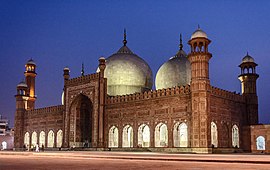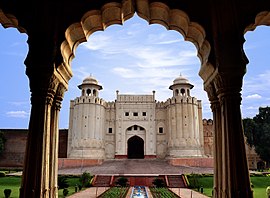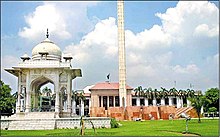Lahore
Appearance








Lahore (/ləˈhɔːr/; Punjabi: لہور; Urdu: لاہور, pronounced [lɑːˈɦɔːr]) is the capital of the Pakistani province of Punjab, and is the country's 2nd largest city after Karachi, as well as the 18th largest city proper in the world. Lahore is one of Pakistan's wealthiest cities with an estimated GDP of $65.14 billion (PPP) as of 2017. Lahore is the largest city and historic cultural centre of the wider Punjab region, and is one of Pakistan's most socially liberal, progressive, and cosmopolitan cities.
Quotes
[edit]- I loved Lahore. By the time I was at secondary school we had moved from Race Course Road to our own apartments in a large block which my paternal grandfather had built for his five children. These were on Nicholson Road, but very close to the tiny streets and shops of Qila Gujyar Singh, an old Sikh-dominated locality, constructed around a small Sikh fortress. The street names were unchanged. Not that I ever asked myself what had happened to all the Sikhs. My early childhood was dominated by kite-flying and playing cricket with street urchins. It wasn't till much later that I even discovered that Basant, the festival of kites, when the Lahore sky is filled with different colours and shapes as old rivals seek to tangle with and cut down each other's kites, was the millennium-old product of Hindu mythology.
- Tariq Ali - The Clash of Fundamentalisms, Crusades, Jihads and Modernity (2002)
- The centre of the town was swathed in red flags. It was my first demonstration and one that I remember to this day. The city was Lahore, which for many centuries had been a much envied metropolis in Northern India. Then the last conquerors had departed, leaving behind a divided subcontinent. The old town had become part of a new country – Pakistan. The founder of this state, Mohammed Ali Jinnah, an agnostic, had cynically used religion to create a ‘Muslim nation’. Jinnah had expressed the hope that Pakistan would, despite everything, remain a secular state, but the logic of history had proved fatal. All the Hindu and Sikh families in Lahore had fled across confessional frontiers. Little ‘Lahores’ had sprung up in Delhi.
- Ali, Tariq - Street fighting years, an autobiography of the sixties (2018)
- For my parents, most of whose friends suddenly vanished, Lahore in the fifties was like a ghost town. The pain of Partition has been sensitively depicted in a number of short stories by the Urdu writer, Saadat Hasan Manto, and by poets like Faiz Ahmed Faiz and Sahir Ludhianvi. I had been three and a half years old in 1947. Pre-Partition Lahore, for me, existed only in numerous overheard conversations. The recent past became a subject for discussions, sometimes heated, but more often sad, and these could be heard in every quarter of the city. They frequently centred on the vibrancy of the town. During the twenties, thirties and forties, it had been an important cultural centre, a home for poets and painters, a city that was proud of its cosmopolitanism. Nineteen forty-seven had changed all that for ever. The old coffee houses and teashops were still in place, but the Hindu and Sikh faces had disappeared, never to return. This fact was soon accepted; political gossip and poetry reasserted their old primacy under new conditions.
- Ali, Tariq - Street fighting years, an autobiography of the sixties (2018)
- from the destined walls
Of Cambala, seat of Cathian Can,
And Samarchand by Oxus, Temir's throne
To Paquin of Sinæan Kings; and thence
To Agra and Lahore of Great Mogal.- John Milton's Paradise Lost, Book. XI, p. 1
Alexander Burnes, (1834)
[edit]- “It is said that Cabool was formerly named Zabool, from a kaffir, or infidel king, who founded it; hence the name of Zaboolistan. Some authors have stated, that the remains of the tomb of Cabool, or Cain, the son of Adam, are pointed out in the city; but the people have no such traditions. It is, however, a popular belief, that when the devil was cast out of heaven, he fell in Cabool. In Cabool itself there are not exactly traditions of Alexander, but both Herat and Lahore are said to have been founded by slaves of that coĵnqueror, whom they call a prophet. Their names were Heri (the old name of Herat) and Lahore. Candahar is said to be an older city than either of these.”
Old Lahore: Reminiscences Of A Resident (1924)
[edit]- "Beyond the fact of its Rajput origin, hardly anything can be recorded with certainty of the history or even of the existence of Lahore until the period of the Muhammadan invasion. A far less dubious mention of Lahore is found, as pointed out by Major-General Cunningham, in the itinerary of Hwan Thsang, the Chinese traveller, who visited the Punjab A. D. 630. He speaks of a large city, containing many thousands of families, chiefly Brahmans, situated on the eastern frontier of the kingdom of Cheka, which, he says, extended from the Indus to the Byas. From this city he proceeded eastward to China Pati, and thence to Jalandhara, the modern Jullundur. Now Jullundur is situated almost due east of Lahore, and midway between the two cities is a village called Patti to this day. There can be little doubt, therefore, that the great Brahmanical city of Hwan Thsang was the city of Lahore. It is probable that at Lahore, as in most Eastern States, there were frequent changes of dynasty. The earliest princes were perhaps Rajputs from Ayodha, of the same family as those who reigned in Guzerat and Mewar. Subsequently—but when, it is impossible to say—the sceptre seems to have passed into the hands of Rajputs of other tribes, such as the Solankhis and the Bhatis. At the period of the first appearance of the Muhammadan, Lahore was in the hands of a " Chauhan prince of the family of Ajmer," and during the latter invasions of the tenth century the reigning family is Brahmanical."
Lahore during the Partition of India
[edit]- The gutters of Lahore were running red with blood. The beautiful Paris of the Orient was a vista of desolation and destruction. Whole streets of Hindu homes were ablaze while Moslem police and troops stood by watching. At night, the sounds of looters ransacking those homes seemed to Atkins like the crunch of termites boring into logs.
- Dominique Lapierre, Dominique Lapierre, Larry Collins - Freedom at Midnight (2011, Vikas Publishing House) Freedom at Midnight, 1975
- I am grieved to learn that people are running away from the west Punjab, and I am told that Lahore is being evacuated by the non-Muslims. I must say that this is what it should not be. If you think Lahore is dead or is dying do not run away from it, but die with what you think is the dying Lahore.
- Mahatma Gandhi. Collected Works 89.11. also in Tribune: 8-8-47. "Mahatma Gandhi advised Congressmen who met him at the residence of Mrs. Rameshwari Nehru at Lahore on 6-8-47 that they should die with dying Lahore." quoted in Talib, S. G. S. (1950). Muslim League Attack on Sikhs and Hindus in the Punjab, 1947. Amritshar: Shiromani Gurdwara Parbandhak Committee.
- “In short, Lahore is the city of the dead and a complete picture of hell. Those in charge of this hell are so perfect in their jobs and carry out the various items of their jobs with efficiency which is unprecedented.”
- The Hindustan Times, quoted in Talib, S. G. S. (1950). Muslim League Attack on Sikhs and Hindus inthe Punjab, 1947. Amritsar: Shiromani Gurdwara Parbandhak Committee. [1] [2] [3] (p 128-9 )
- The Hindus of the Punjab had quite as heavy an economic stake in these districts as the Sikhs, and more so even in Lahore, which town owed almost its entire wealth, industry, educational enterprise, and importance to the vast effort the Hindus had been expending for generations in building it up. Sikh enterprise in developing Lahore was second only to the Hindu-the Muslims there being backward and unenterprising, consisting mostly of migratory seasonal labourers or petty hawkers.
- Talib, S. G. S. (1950). Muslim League Attack on Sikhs and Hindus inthe Punjab, 1947. Amritsar: Shiromani Gurdwara Parbandhak Committee. [4] [5] [6] (p 99)
- But the Muslim. Leaguers wanted to drive all Hindus and Sikhs from Lahore. If Lahore came to Pakistan, it would have been a good riddance and action according to plan if Hindus and Sikhs were made to vacate Lahore. It was calculated that the vast wealth accumulated by Hindus and Sikhs for generations in this magnificent city would fall into the hands of Muslims. If Lahore by any chance was allotted to India, it would have been a good thing to have destroyed this fine city, and to make a present of heaps of ashes and cinders to the new rulers of India on August 15, 1947. Such calculation and surging hate and malice appear to have directed the course of Muslim action in Lahore in the months from the beginning of June onwards. It is said also that the Muslim goondas of Lahore were put to shame by their compeers in Amritsar, who had done extremely well in murdering Hindus and Sikhs of that city and in reducing about a quarter of the town of Amritsar to ashes. In an interview to the Press Mr. Eustace, District Magistrate of Lahore revealed that the Muslim goondas of Amritsar sent, as a mark of sarcastic provocation churis (glass bangles) and mehndi (henna) to the goondas of Lahore, implying lack of manliness and feminity in them in not having ‘done’ anything against Hindus and Sikhs. The Lahore goondas were evidently stung to the quick, and stirred their ‘manliness’ not a little, by setting fire to a good part of the Hindu and Sikh localities of Lahore and letting loose on the city a campaign of stabbing and looting, which went on unimpeded with active police and official support. (101)
- Talib, S. G. S. (1950). Muslim League Attack on Sikhs and Hindus inthe Punjab, 1947. Amritsar: Shiromani Gurdwara Parbandhak Committee. [7] [8] [9] (p 101)
Also See
[edit]
